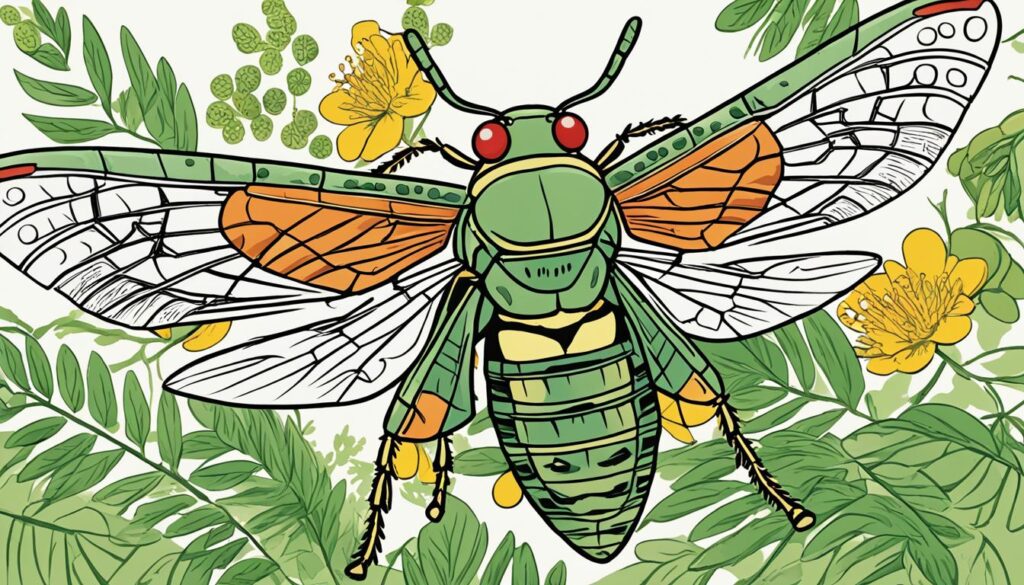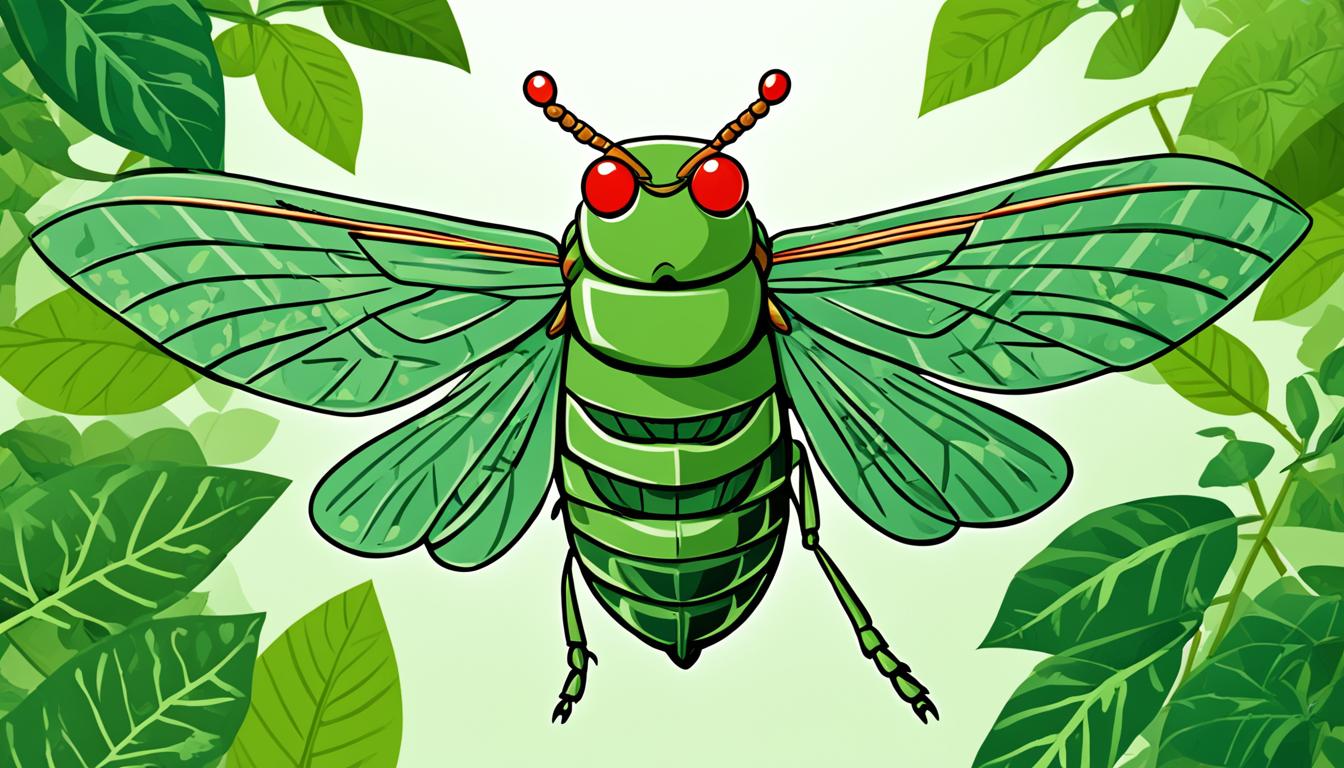In Japan, the fascinating insect known as the cicada holds significant symbolism and cultural importance. Let’s explore the native term for cicada in Japanese and delve into the cultural fascination with these singing insects. Whether you’re interested in Japanese cicada species or the cicada life cycle in Japan, this article will provide you with all the information you need.
What is a Cicada?
A cicada is a fascinating insect that belongs to the hemiptera order, specifically the superfamily Cicadoidea. It is commonly known for its distinctive buzzing sound that fills the summer air. Cicadas are part of the Animalia kingdom, Euarthropoda phylum, Insecta class, Hemiptera order, Cicadomorpha infra order, and Cicadoidea superfamily.
There are over 1,300 species of cicadas worldwide, each with its own unique characteristics and habitat. They can be found in various regions, including Japan, where they play a significant role in the local ecosystem.
Cicadas undergo a fascinating life cycle that spans several years. It begins with female cicadas laying eggs in slits they make in tree branches. Once hatched, the young cicadas, known as nymphs, burrow into the ground where they feed on root sap for several years. This period of development underground can range from a few years to over a decade, depending on the species.
When the time is right, nymphs emerge from the ground and climb onto trees or other vertical surfaces. They then molt, shedding their exoskeleton to reveal their adult form. The newly emerged cicadas have soft bodies and wings that gradually harden over several hours.
Once cicadas have completed their transformation, they take to the skies as fully mature adults. These winged insects primarily feed on sap, using their specialized mouthparts to pierce the bark of trees and extract nutrients. The buzzing sound that cicadas produce is actually their mating call, emitted by males to attract females.
Overall, cicadas are fascinating insects that play a crucial role in ecosystems around the world. Their emergence and distinctive sounds mark the arrival of summer and capture the curiosity of nature enthusiasts.
| Key Facts about Cicadas | |
|---|---|
| Kingdom: | Animalia |
| Phylum: | Euarthropoda |
| Class: | Insecta |
| Order: | Hemiptera |
| Superfamily: | Cicadoidea |
| Species: | Over 1,300 worldwide |
| Habitat: | Varying regions, including forests |
| Life Cycle: | Egg – Nymph – Adult |
| Food: | Sap from trees |
The Cicada Species Found in Japan
In Japan, the most common species of cicada is the Tanna Japonensis, also known as “Higurashi” in Japanese. It is an evening cicada and can be found not only in Japan but also in other parts of East Asia. This species belongs to the Cicadidae family and has distinctive characteristics such as reddish-brown hues and shades of green.
The Habitat of the Cicada
Cicadas are fascinating insects known for their adaptability to various environments. In Japan, they can be found thriving in both subtropical and temperate conditions, spanning from Hokkaido to Amami Oshima. These resilient creatures are not limited to specific landscapes and can be discovered in diverse habitats, including the lush Japanese forests.
Japanese forests provide an ideal habitat for cicadas, offering a rich variety of tree species for them to inhabit. Cypress, hardwood, and cedar trees are among the favorites of these singing insects. The dense foliage and towering canopies provide the perfect shelter and food source for cicadas, enabling them to complete their life cycle and thrive in abundance.
These forests create a harmonious environment for cicadas, providing ample shade and protection from predators, while at the same time granting them easy access to the nutrients they need to survive. The cicada’s dependence on Japanese forests highlights the intricate relationship between these insects and their natural habitat.
| Characteristics of Cicada Habitat in Japanese Forests | Advantages for Cicadas |
|---|---|
| Biodiversity | Allows cicadas to coexist with a wide variety of other plant and animal species, contributing to a balanced ecosystem. |
| Shelter | Provides ample hiding spaces and protection from extreme weather conditions, ensuring cicadas’ survival. |
| Food Source | The abundance of trees in Japanese forests provides cicadas with a sustainable and abundant source of sap, their primary food. |
| Life Cycle Support | Allows cicadas to complete their underground nymph stage and molt into their flying forms, ready for mating. |
The Different Kinds of Cicada in Japan

Japan is home to more than 30 different species of cicadas. Each species has its own unique characteristics and distinctive songs. Here are some common cicada species found in Japan:
| Cicada Species | Japanese Name |
|---|---|
| Auritibicen flammatus | Min-min-zemi |
| Yezoterpnosia Nigricosta | Tsuku-tsuku-boshi |
| Graptopsaltria nigrofuscata | Kumazemi |
| Auritibicen kyushyuensis | — |
These cicadas mesmerize with their melodies and add to the symphony of sounds in the Japanese summer.
Captivating creatures, cicadas showcase the rich biodiversity of Japan.
Research on The Sounds the Cicada Makes
Scientists have conducted extensive cicada sound research to understand the fascinating world of these singing insects. Using modern technology such as lasers, researchers have been able to measure the vibrations produced by cicadas and gain insights into how they create their unique songs.
Cicadas produce sound by vibrating their exoskeletons. This vibration creates the characteristic buzzing noise that is synonymous with cicadas. Each species of cicada has its own distinct song, with variations in pitch, rhythm, pattern, and melody.
Why Do Cicadas Make That Noise?
The loud buzzing noise produced by cicadas is primarily attributed to the mating calls of male cicadas. Male cicadas create their distinctive songs to attract female cicadas for mating. This behavior is driven by the natural instincts of cicadas to reproduce and ensure the continuation of their species. The unique calls serve as a form of communication and identification within the cicada community.
When a male cicada finds a suitable location, such as a tree branch, he begins his mating call by flexing his tymbals, which are special sound-producing organs found on his abdomen. This flexing creates vibrations that resonate through the tymbals, producing the characteristic buzzing sound that is synonymous with cicadas.
Each species of cicada has its own specific mating call, with variations in pitch, rhythm, pattern, and melody. These variations help in distinguishing different species and play a crucial role in attracting potential mates. The calls of male cicadas can reach incredibly high decibel levels, often exceeding 100 decibels, making them some of the loudest insects in the world.
Interestingly, once a male cicada attracts a female with his mating call, he reduces the volume of his song, signaling his interest and readiness to mate. This change in volume helps the female locate the male amidst the cacophony of other cicada calls.
To prevent their own hearing from being impaired by their loud noise and the noise produced by other cicadas, cicadas have developed the ability to switch off their hearing. This unique adaptation allows them to focus on producing their calls without being overwhelmed by the surrounding noise. After all, their survival and reproduction depend on successfully attracting mates.
Cicadas and Their Significance in Japanese Culture
Cicadas hold significant symbolism in Japanese culture. The cicada in Japanese is known as “semi,” and it is closely associated with the summer season in Japan. The sound of cicadas singing is considered a symbol of summer and represents the passing of time in Japanese culture. The loud chorus of cicadas is heard throughout the country during the hot summer months, creating a distinctive ambiance.
In Japanese literature, cicadas have been referenced for centuries and are seen as a representation of the beauty and transience of life. The cicada’s short lifespan, which lasts only a few weeks, is a metaphor for the transient nature of human existence. This symbolism is often used to evoke feelings of nostalgia, impermanence, and the bittersweet beauty of fleeting moments in Japanese poetry and art.
Cicada motifs can be found in various forms of Japanese artwork, such as paintings, prints, textiles, and ceramics. These symbols of summer are also featured in traditional festivals, where cicada-shaped decorations and ornaments are used to celebrate the season. The presence of cicadas in Japanese culture serves as a reminder to appreciate the fleeting moments of life and find beauty in the transient nature of existence.

